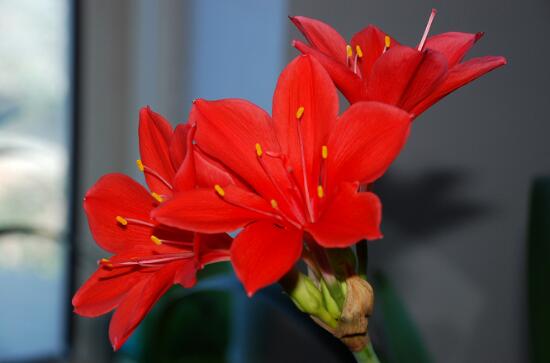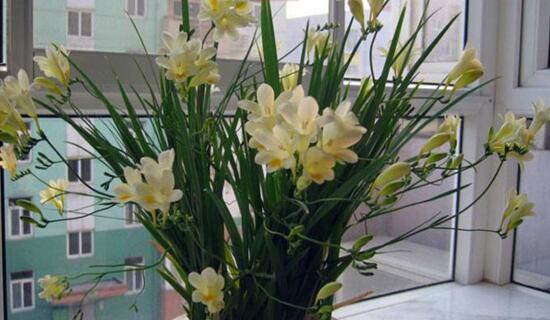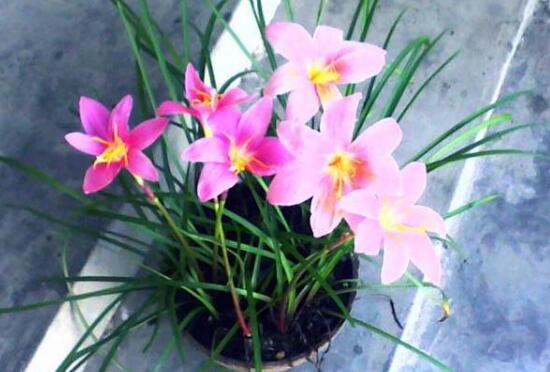Purple root orchid blossoms several times a year. Why doesn't purple root orchid blossom / bloom twice a year?
Purple root orchid, a common indoor flower, is shaped like a lily, beautiful in color and beautiful against the surrounding green leaves. However, in the process of breeding, many flower friends' purple root orchids do not blossom, so why do not purple root orchids bloom? It is said that if properly maintained, how long can purple root orchid blossom in a year, and how many times a year can purple root orchid bloom? Today, the editor is here to solve this problem for everyone.
Purple root orchid blossoms several times a year, twice a year

Generally speaking, purple root orchid can only blossom once a year, but this is only for ordinary flower friends. It is understood that if you are an old hand, and then strictly follow the cultivation method of purple orchid, purple root orchid can blossom twice a year: the first meeting is in February-April, and the second flowering is in summer August-September.
Second, why the purple root orchid does not bloom, there are five reasons
The efficacy of purple root orchid is good, it not only blossoms the beauty, but also can beautify the home, purify the air. But the purple root orchid blossoms, and once it doesn't blossom, it's all in vain. Then why doesn't purple root orchid blossom? In this regard, the editor summarized five reasons and attached solutions, as follows:
1. Temperature discomfort
Purple root orchid likes a warm environment, it avoid high temperature, not cold-resistant, so once the temperature is too high or too low, it will cause purple root orchid not to blossom.
Solution: if the purple root orchid does not blossom caused by temperature, it is very simple to control the room temperature at 10-25 ℃, and then carefully maintain for a period of time, the flowers will slowly bloom.
2. The light is too strong
Why doesn't purple root orchid blossom? In addition to temperature, the first thing that comes to mind is light. Purple root orchid blossoms need plenty of light, but it avoids strong light. In summer, if you give purple root orchid the noon sun, it will cause leaf damage. In serious cases, it will affect the growth of purple root orchid, and you don't have to think about flowering.
Solution: move the plant to a ventilated shade, and pour the right amount of water, careful maintenance for a period of time, as long as the purple root orchid flowering, it will still blossom.
3. Overwatering
Purple root orchid likes a humid environment, so there is a requirement for moisture. But because many of the flower lovers who raise purple root orchids are novice, it is inevitable that there will be more watering. Once there is water in the basin, it will cause the purple root to rot, the roots are rotten, and the flowers will not bloom naturally.
Solution: remove the purple root from the pot, cut off the rotten roots, replace it with fresh culture soil, and then replant it. After that, pay attention to keep the basin soil of purple root orchid slightly dry, and after a period of time, purple root orchid will bloom.
4. Soil discomfort
If purple root orchid flowering is not a conservation problem, then we should look at the root causes, such as to see if there is something wrong with the soil. It is understood that when raising purple root orchids, if flower friends directly use garden soil, the plants will not blossom because of insufficient absorption of nutrients.
Solution: when cultivating purple orchid, it is best to choose a soil that is loose and fertile, well drained and rich in humus. Therefore, if the purple root orchid does not blossom caused by soil discomfort, you can replace it with the soil it likes.
5. Poor ventilation
Why doesn't purple root orchid blossom? In addition to the above points, we should also consider environmental issues. In daily maintenance, purple root orchid likes a ventilated environment, if it is placed in an unventilated place, a long time will attract a lot of insects, causing purple root orchid to suffer insect pests, the result will not blossom naturally.
Solution: simply move the purple root orchid to a ventilated place, then spray the relevant insect medicine, and then carefully maintain it for a period of time. If the flowering period is not over, the purple root orchid will blossom.
How to cultivate the growth habits of Polymeric Grass
SymphytumofficinaleL, alias Patriotic Grass, Leymus chinensis, Friendship Grass, Friendship Grass, Purple Root Grass, Rehabilitation Force, Exotic Polymeric Grass, Ximen Lung Grass, Arnebia Root. Herbs tufted perennial, 30-90 cm tall, entire plant slightly arcuate hirsute and pubescent. Born in mountains and forests, it is a typical mesophyte. Originally from the European part of the Soviet Union and the Caucasus, China gave it to China as a precious gift from North Korea in 1973 and has been introduced and cultivated ever since. Polymeric grass has wide adaptability, high yield, long utilization period and good palatability. it is a high-quality and high-yield livestock and poultry feed crop. It also has high nutritional value, can be used as medicine, but also has certain ornamental value.
Morphological characteristics of Polymeric Grass
The rhizome aggregate grass is a tufted perennial herb with a height of 30-90 cm and the whole plant is covered with slightly curving bristles and short hairs. The root is well developed, the main root is stout, lavender brown. Stems several, erect or obliquely ascending, branched.
The basal leaves are usually 50-80, up to 200, with long stalks, and the leaf blade is banded-lanceolate, ovate-lanceolate to ovate, 30-60 cm long, 10-20 cm wide, slightly fleshy, apex acuminate; middle and upper leaves of stem are smaller, sessile, base decurrent.
Inflorescences of flowers with many flowers; Calyx lobed near base, lobes lanceolate, apex acuminate; Corolla 14-15 mm long, lavender, purple to yellowish white, lobes triangular, apex revolute, throat appendages lanceolate, ca. 4 mm, not protruding from Corolla; anthers ca. 3.5 mm long, apical connective slightly prominent, filaments ca. 3 mm, lower part as wide as anthers. Ovary usually sterile, occasionally ripening 1 nutlet in individual flowers.
Nutlets crooked-ovate, 3-4 mm long, black, smooth, glossy.
The flowering period of aggregate grass is from May to October.
Ecological habits of aggregate grass
Polymeric grass is a typical mesophyte growing in mountains and forests. Suitable for a wide range of areas, aggregate grass is both cold-resistant and high-temperature resistant, not subject to regional restrictions; there are no strict requirements for soil, except saline-alkali land, thin ridge land and poorly drained low-lying land, general land can be planted. Large-scale farms can be cultivated in large areas of farmland or barren mountains, and farmers can grow in front of houses, by riverside roads, barren slopes and other wasteland.
Cultivation techniques of aggregate Grass
Pre-planting preparation
Site selection and cultivation
It is most suitable to choose the land with flat terrain, deep soil layer, more organic matter, good drainage and irrigation conditions. Aggregate grass is a perennial plant with well-developed roots and strong regeneration, so it is generally not suitable for rotation with field crops.
Soil preparation and fertilization
Turn deeply before planting, ploughing depth should be more than 25 cm, rake flat in time after ploughing. It should be combined with ploughing to apply sufficient basic fertilizer, with semi-rotten pig, cow and sheep manure as good, with a fertilizer application amount of 2500-4000 kg per mu.
Cultivation method
The flowering of polymeric grass is not fruitful or very few, and the polymeric grass root (mother root) which has been growing for more than one year is often used as seedling planting. It is generally planted in spring and autumn. Seedling bed seedlings can be transplanted from April to October, but it is better from March to April and from September to October. When planting, it is appropriate to have a seedling height of 15 cm and 5 leaves, and it is best to choose a rainy day. It is best to work continuously for root digging, root cutting and planting to improve the survival rate. The planting row spacing is 50 cm to 60 cm, and the plant spacing is 40 cm to 50 cm. The commonly used planting methods are root cutting method and plant division method.
Root cutting method
The fleshy root of aggregate grass has a strong ability to produce adventitious buds and adventitious roots, and all roots with a diameter of more than 0cm can be cut and planted. The root segment planted in a large area is 3-5 cm in length and not less than 0.5 cm in diameter. Roots larger than 1 cm in diameter can be cut directly into two flaps, and thicker ones can be longitudinally cut into 3-4 flaps. In general, the thicker the root, the longer the root segment, the faster the germination and growth. When raising seedlings, put the root section horizontally in the soil, covering the soil 2 cm to 3 cm deep. When the temperature is above 18 ℃, the seedlings can emerge in 30-40 days.
Split-plant method
After digging up the robust plant by root, leave stubble 5cm and 6cm, cut off the upper stem and leaf, cut longitudinally from the root neck (with skin), 1-2 buds on each ramet, which can be directly planted in the field after cutting, and new leaves can grow in 5-6 days. This method has the advantages of fast survival and rapid growth, and the yield is high in the same year, but the reproduction coefficient is low. Each plant can be divided into 10-20 plants. This method can be used when the seed root is sufficient.
Growing environment
Strong resistance to adversity
Heat resistance: it can grow normally when the temperature is higher than 40 ℃ and under strong light.
Keep out the cold: at 40 ℃ below zero, its robust underground part can survive the winter safely in the open field.
Weed tolerance: after the second year of cultivation. Return to green early, close quickly, its broad leaves will cover the surface, it is difficult for weeds to grow and multiply.
The utilization period is longer.
Polymeric grass is a perennial persistent root plant with strong vitality, which can be used for about 10 years at a time, compared with forage plants that can only be used for one year at a time, twice the result with half the effort.
Temperature
22 ℃ ~ 28 ℃ grew fastest, grew slowly when autumn and winter was less than 7 ℃, stopped growing when it was less than 0 ℃, and began to germinate at 0 ℃ ~ 7 ℃ in early spring.
Light
Aggregate grass not only likes the sun but also tolerates shade. It needs sufficient light during the vegetative growth period, but it is also very shade-tolerant. It can also grow well when asked for seeds in orchards or under the forest.
Moisture content
The plant is sensitive to water, and the seedlings wilt suddenly from the soil, and the watering is fresh; when the soil water capacity drops to 30%, the growth is slow, and withering occurs. However, after one night, especially after a long drought and rain, the fork can resume its growth; when the temperature is above 20 ℃ and the soil water holding capacity is 70% to 8o%, the growth is the fastest, with an average daily growth of 2-3cm.
Management and maintenance of aggregate grass
Intermediate ploughing and weeding
After the planting survived, the first intertillage weeding was carried out, and the second and third intertillage weeding and soil cultivation were carried out before closing rows or ridges. After each harvest, combined with fertilization, one-time ploughing and weeding was carried out to loosen the soil, maintain soil moisture, improve soil aeration conditions and facilitate regeneration.
Topdressing irrigation
Polymeric grass has large leaves, rapid growth, more harvesting times, high yield and more fertilizer than ordinary plants. Topdressing should be done once after planting and before turning green every year. After each harvest, combined with ploughing and weeding, quick-acting nitrogen fertilizer was applied once, and ammonium sulfate 1015kg or rotten fecal urine 750kg was applied every 667 square meters. Topdressing should be applied next to the plant, not on the leaves or roots. In the dry season, irrigate once after each harvest and topdressing. It is not suitable to flood irrigation, but ditch irrigation and then splash water to prevent rotting roots and dead plants. Ditches should be opened to drain waterlogging in rainy season.
Harvest
The forage part of aggregate grass is leaf and stem, which can be cut 4 ~ 5 times a year, and can be cut once ~ 2 times in the year of planting. There are also differences in different cutting periods, and it can be used as green fodder. the polymeric grass has high yield and rich nutrition from budding to flowering stage, so it is the suitable time for harvest. When it is used as silage or preparing hay, it should be cut at the full flowering stage with high dry matter content. When the harvest was too late, the stems and leaves became yellow, the stems became old, and the yield and quality decreased. It also affects the growth of aggregate grass and the yield of the next cutting, and reduces the cutting times. The early harvest has low yield, low nutrient content, low total dry matter yield, and less nutrients accumulated in the root, which affects its regeneration ability. Cut green should also be determined according to the feeding object, cattle, sheep, pigs should be cut old, chickens, ducks, geese, rabbits, ostriches should be cut tender. The stubble height of aggregate grass has a great influence on the growth, development and yield.
Although the yield of ground-to-ground cutting is high, it turns green slowly, and the yield of the next few crops is low. Stubble is too high, the loss and waste is serious, generally stubble height 5 cm ~ 6 cm. The last harvest should be completed 30 days before stopping growth, in order to have enough regeneration period and accumulate sufficient nutrients, which is conducive to the formation of overwintering buds and safe overwintering.
Disease Control of Polymeric Grass
Disease prevention and cure
Brown spot and blight
The polymeric grass is easy to suffer from brown spot and blight in the environment of high temperature and humidity, so it is necessary to dig up the diseased plants and burn them or bury them deeply as soon as possible, and at the same time, sprinkle the soil with 80% carbendazim 500 times or 80% mancozeb 800 times solution and spray adjacent plants.
Pest control
Ground tigers and grubs
In the seedling stage, there are underground pests such as ground tiger and grub, which can be irrigated with 1000-1500 times liquid of trichlorfon. There are mainly yellow striped jumping beetles in the growing period. At the time of occurrence, a mixture of 400-fold diazepam emulsion and 1500-fold dichlorvos spray was used. If whitefly sucks leaf juice, it can be sprayed with 3% high chlorine imidacloprid 600 × 700 times to kill the pest.
Distribution area of Polymeric Grass
The aggregate grassland is produced in the European part of the Soviet Union and the Caucasus.
Aggregate grass is also distributed in Jiangsu Province, Fujian Province, Hubei Province, Sichuan Province and so on.
After reading the above introduction on how to cultivate aggregate grass, do you know more about the cultivation of aggregate grass? if you want to know more about it, please continue to pay attention.
- Prev

How to plant potted ginger flowers, the cultivation methods of ginger flowers / five techniques can be exploded.
Ginger flower is not only beautiful in shape, but also has high edible and medicinal value. Many flower lovers choose to plant ginger flower precisely because of its many effects and functions, but they need to have some understanding of its planting skills before raising it. And how to plant potted ginger flowers? Let's take a look at the culture methods of ginger flowers.
- Next

What about the yellowing of orchid leaves? control watering, appropriate amount of fertilization / change of basin soil to recover quickly.
Wind and rain orchid, a very beautiful flower, is shaped like a trumpet and has various colors. It is particularly beautiful against the green leaves. But in the maintenance process, many flower friends keep the leaves yellow, then the wind and rain orchid leaves yellow how to do? At this time, flower friends must calmly find the cause, and then deal with it accordingly.
Related
- Fuxing push coffee new agricultural production and marketing class: lack of small-scale processing plants
- Jujube rice field leisure farm deep ploughing Yilan for five years to create a space for organic food and play
- Nongyu Farm-A trial of organic papaya for brave women with advanced technology
- Four points for attention in the prevention and control of diseases and insect pests of edible fungi
- How to add nutrient solution to Edible Fungi
- Is there any good way to control edible fungus mites?
- Open Inoculation Technology of Edible Fungi
- Is there any clever way to use fertilizer for edible fungus in winter?
- What agents are used to kill the pathogens of edible fungi in the mushroom shed?
- Rapid drying of Edible Fungi

